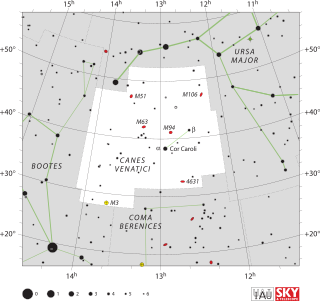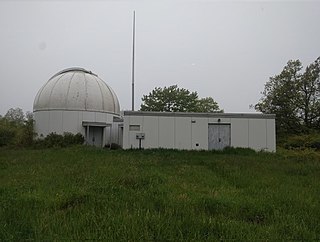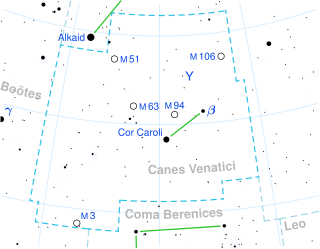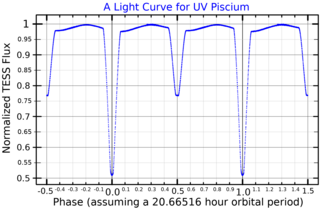
Canes Venatici is one of the 88 constellations designated by the International Astronomical Union (IAU). It is a small northern constellation that was created by Johannes Hevelius in the 17th century. Its name is Latin for 'hunting dogs', and the constellation is often depicted in illustrations as representing the dogs of Boötes the Herdsman, a neighboring constellation.
A flare star is a variable star that can undergo unpredictable dramatic increases in brightness for a few minutes. It is believed that the flares on flare stars are analogous to solar flares in that they are due to the magnetic energy stored in the stars' atmospheres. The brightness increase is across the spectrum, from X-rays to radio waves. Flare activity among late-type stars was first reported by A. van Maanen in 1945, for WX UMa and YZ CMi. However, the best-known flare star is UV Ceti, first observed to flare in 1948. Today similar flare stars are classified as UV Ceti type variable stars in variable star catalogs such as the General Catalogue of Variable Stars.

The Black Moshannon Observatory (BMO) was an astronomical observatory owned and operated by Pennsylvania State University. Established in 1972, it was located in the central part of the U.S. state of Pennsylvania in Black Moshannon State Park, approximately 17 kilometers (11 mi) northwest of State College. The observatory was closed some time after August 1995.
Xi Ursae Majoris is a star system in the constellation of Ursa Major. It has the traditional name Alula Australis; Xi Ursae Majoris is the Bayer designation, which is Latinised from ξ Ursae Majoris and abbreviated Xi UMa or ξ UMa. It was the first visual double star for which an orbit was calculated, when it was computed by Félix Savary in 1828. It is also a variable star with a small amplitude. Xi Ursae Majoris is found in the left hind paw of the Great Bear.

An RS Canum Venaticorum variable is a type of variable star. The variable type consists of close binary stars having active chromospheres which can cause large stellar spots. These spots are believed to cause variations in their observed luminosity. Systems can exhibit variations on timescales of years due to variation in the spot surface coverage fraction, as well as periodic variations which are, in general, close to the orbital period of the binary system. Some systems exhibit variations in luminosity due to their being eclipsing binaries. Typical brightness fluctuation is around 0.2 magnitudes. They take their name from the star RS Canum Venaticorum.

Beta Canum Venaticorum, also named Chara, is a G-type main-sequence star in the northern constellation of Canes Venatici. At an apparent visual magnitude of 4.25, it is the second-brightest star in the constellation. Based upon an annual parallax shift of 118 mas, this star is 27.6 light-years distant from the Sun.

42 Capricorni is a binary star system in the zodiac constellation of Capricornus. It has a combined apparent visual magnitude of 5.18, so it is faintly visible to the naked eye. Its annual parallax shift of 30.09 mas yields a distance estimate of about 108 light years; the system is moving closer to the Sun with a radial velocity of −1.2 km/s. 42 Capricorni is 0.2 degree south of the ecliptic and so is subject to lunar occultations.

II Pegasi is a binary star system in the constellation of Pegasus with an apparent magnitude of 7.4 and a distance of 130 light-years. It is a very active RS Canum Venaticorum variable, a close binary system with active starspots.

HR 5110, also known as BH Canum Venaticorum, is a binary star system in the northern constellation of Canes Venatici. It is visible to the naked eye with an apparent visual magnitude of 4.91. Based upon an annual parallax shift of 21.90±0.23 mas, it is located 149 light-years away. The system is moving further from the Sun with a heliocentric radial velocity of 6.4 km/s.

Sigma Geminorum is a binary star system in the constellation Gemini, just to the northeast of Pollux. It is visible to the naked eye with an apparent visual magnitude of 4.20. Its annual parallax shift of 26.08 mas indicates that it is located 125 light years from the Sun.

Sigma Coronae Borealis is a star system in the constellation of Corona Borealis. It is a quintuple star system containing three sunlike main-sequence stars and two other low-mass stars. The combined visual magnitude is 5.3 and the system lies 74 light years from Earth. σ CrB A is the variable star TZ Coronae Borealis.

13 Ceti is a triple star system in the equatorial constellation of Cetus. It is dimly visible to the naked eye with a combined apparent visual magnitude of 5.20. The system is located at a distance of approximately 69 light years from the Sun based on stellar parallax, and is drifting further away with a radial velocity of +10.4 km/s. It shares a common motion with the Hyades moving group, although it is too old to be a member.

RS Canum Venaticorum is a binary star system in the northern constellation of Canes Venatici. It serves as the prototype to the class of RS Canum Venaticorum variables. The peak apparent visual magnitude of this system is below the level needed to observe it with the naked eye. It is located at a distance of approximately 443 light years from the Sun based on parallax, but is drifting closer with a net radial velocity of −14 km/s. Olin J. Eggen (1991) included this system as a member of the IC 2391 supercluster, but it was later excluded.

XY Ursae Majoris is a short period binary star system in the northern circumpolar constellation of Ursa Major. It is an eclipsing binary with a baseline apparent visual magnitude of 9.50. The system is located at a distance of 221.5 light years from the Sun based on parallax measurements, but is drifting closer with a radial velocity of −10 km/s. It has a relatively high proper motion, traversing the celestial sphere at the angular rate of 0.191″·yr−1.

SZ Piscium is a suspected triple star system in the equatorial constellation of Pisces. The inner pair form a double-lined spectroscopic binary with an orbital period of 3.966 days. It is a detached Algol-type eclipsing binary of the RS Canum Venaticorum class with a subgiant component. The system is too faint to be readily visible to the naked eye with a combined apparent visual magnitude of 7.18. It is located at a distance of approximately 306 light years based on parallax measurements.

BH Virginis is a binary star system in the equatorial constellation of Virgo. With a typical apparent visual magnitude of 9.6, it is too faint to be visible to the naked eye. Based on parallax measurements, it is located at a distance of approximately 488 light years from the Sun. The system is drifting closer with a net radial velocity of −23 km/s.

UV Piscium is a binary star system in the constellation of Pisces. With a peak apparent visual magnitude of 8.98, it is too faint to be visible to the naked eye. This is an eclipsing binary system that decreases to magnitude 10.05 during the primary eclipse, then to magnitude 9.54 with the secondary eclipse. It is located at a distance of 232 light years from the Sun based on parallax measurements, and is receding with a radial velocity of 6.5 km/s. The position of this star near the ecliptic means it is subject to lunar occultation.

ER Vulpeculae is a binary star system in the northern constellation of Vulpecula, abbreviated ER Vul. It is a variable star system with a brightness that ranges from an apparent visual magnitude of 7.27 down to 7.49, which is too faint to be visible to the naked eye. This system is located at a distance of 165 light years from the Sun based on parallax measurements. It is drifting closer with a radial velocity of −25 km/s.

DM Ursae Majoris is a binary star system in the northern circumpolar constellation of Ursa Major, abbreviated DM UMa. It is sometimes identified by the Bonner Durchmusterung catalogue designation BD +61 1211; DM UMa is the variable star designation. The system has a combined apparent visual magnitude of 9.29, which is too faint to be visible to the naked eye. Based on parallax measurements, the system is located at a distance of approximately 606 light years from the Sun, but it is drifting closer with a heliocentric radial velocity of −7 km/s.

HR 1099 is a triple star system in the equatorial constellation of Taurus, positioned 11′ to the north of the star 10 Tauri. This system has the variable star designation V711 Tauri, while HR 1099 is the star's identifier from the Bright Star Catalogue. It ranges in brightness from a combined apparent visual magnitude of 5.71 down to 5.94, which is bright enough to be dimly visible to the naked eye. The distance to this system is 96.6 light years based on parallax measurements, but it is drifting closer with a radial velocity of about −15 km/s.

















